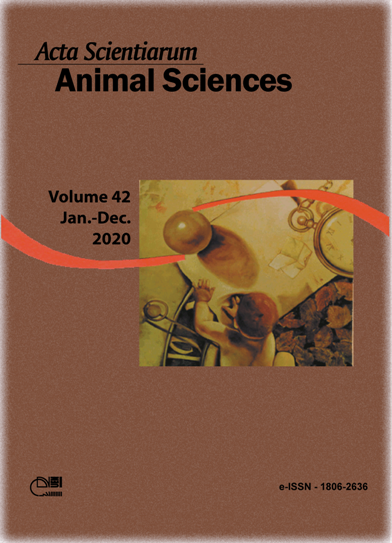A by-product of pinto beans in diets for quail in the laying phase
Abstract
The aim of this study was to evaluate levels of inclusion of pinto beans in diets for quail in the laying phase on their performance and egg quality. A total of 280 Japanese quail in the laying phase were distributed into five treatments in a completely randomized design with eight replicates and seven birds per plot. Treatments consisted of five levels (0, 2, 4, 6, and 8%) of inclusion of pinto beans in the diets, which remained isoenergetic and isoproteic. The experiment began with the quail at 70 days of age and lasted 63 days, with their performance assessed every 21 days and egg-quality parameters on the last two days of each cycle. The following parameters were evaluated: final weight, feed intake, egg-laying rate, feed conversion (per dozen eggs and per egg mass), egg weight, eggshell thickness, specific gravity, yolk color, and weights of shell, yolk, and albumen. No difference was detected between the bean inclusion levels for any of the performance and egg-quality traits assessed or the birds' final weight. In conclusion, up to 8% raw pinto beans may be added in diets for Japanese quail in the laying phase without compromising their performance or internal-external egg quality.
Downloads
References
Alencar, D. P., Maciel, M. P., Botelho, L. F. R., Caldeira, L. A., Souza, L. F. M., Silva, D. B., & Moura, V. H. S. (2014). Feijão guandu cru na alimentação de frangos caipiras criados em sistema semi-intensivo. Pesquisa Agropecuária Brasileira, 49(9), 737-744. doi: 10.1590/S0100-204X2014000900010
Batista, K. A., Prudêncio, S. H., & Fernandes, K. F. (2010). Changes in the functional properties and antinutritional factors of extruded hard-to-cook common beans. Journal of Food Science, 75(3), 286-290. doi: 10.1111 / j.1750-3841.2010.01557.x
Fonseca, N. A. N., Mizubuti, I. Y., Pinheiro, J. W., Khatounian, C. A., Laffranchi, A., Sato, R. Y., ... Daniellides, G. (1995). Efeito do uso do feijão guandu cru moído (Cajanus cajan (L.) Mill sp) sobre o desempenho de poedeiras comerciais. Semina Ciências Agrárias, 16(1), 115-121. doi: 10.5433 / 1679-0359
Instituto Nacional de Ciência e Tecnologia [INCT]. (2012). Métodos para análise de alimentos. Visconde do Rio Branco, MG: Suprema.
Lin, H., Mertens, K., Kemps, B., Govaerts, T., Ketelaere, B., Baerdemaeker, J., … Buyse, J. (2004). New approach of testing the effect of heat stress on eggshell quality: mechanical and material properties of eggshell and membrane. British Poultry Science, 45(4), 476-482. doi: 10.1080/00071660400001173
Lovato, F., Kowaleski, J., Silva, S. Z., & Heldt, L. F. S. (2018). Composição centesimal e conteúdo mineral de diferentes cultivares de feijão biorfortificado (Phaseolus vulgaris L.). Brazilian Journal of Food Technology, 21, 1-6. doi:10.1590/1981-6723.6817
Magalhães, A. L. R., Zorzi, K., Queiroz, A. C., Mello, R., Detmann, E., & Pereira, J. C. (2008). Resíduo proveniente do beneficiamento do feijão (Phaseolus vulgaris L.) em rações para vacas em lactação: consumo, digestibilidade, produção e composição do leite e eficiência de alimentação. Revista Brasileira de Zootecnia, 37(3), 529-537. doi: 10.1590/S1516-35982008000300019
Martín-Cabrejas, M. A., Aguilera, Y., Pedrosa, M. M., Cuadrado, C., Hernández, T., Díaz, S., & Esteban, R. M. (2009). The impact of dehydration process on antinutrients and protein digestibility of some legume flours. Food Chemistry, 114, 1063-1068. doi: 10.1016/j.foodchem.2008.10.070
Mechi, R., Caniatti-Brazaca, S. G., & Arthur, V. (2005). Avaliação química, nutricional e fatores antinutricionais do feijão preto (Phaseolus vulgaris L.) irradiado. Ciência e Tecnologia de Alimentos, 25(1), 109-114. doi: 10.1590/s0101-20612005000100018
Pereira, C. A. S., & Costa, N. M. B. (2002). Proteínas do feijão preto sem casca: digestibilidade em animais convencionais e isento de germes (germ-free). Revista de Nutrição, 15(1), 5-14. doi: 10.1590/S1415-52732002000100002
Rostagno, H. S., Albino, L. F. T., Donzele, J. L., Gomes, P. C., Oliveira, R. F., Lopes, D. C., ... Euclides, R. F. (2011). Tabelas Brasileiras para Aves e Suínos: Composição de Alimentos e Exigências Nutricionais (3a ed.). Viçosa, MG: Editora UFV.
Saeed, M. S. & Abdel Ati, K. A. (2007). Inclusion of pigeon pea (Cajanus cajan) seed on broiler chicks diet. Research Journal of Animal and Veterinary Sciences, 2, 1-4.
Sakomura, N. K., & Rostagno, H. S. (2016). Métodos de Pesquisa em Nutrição de Monogástricos. Jaboticabal, SP: Funep.
Statistical Analysis System [SAS]. (2003). SAS/STAT User’s guide, Version 9.1. Cary, NC: SAS Institute Inc.
Shaahu, D. T., Carew, S. N., & Dzungwe, N. E. (2014). Effect of Using Raw or Processed Lablab Seed as Major Protein Source in Diets on the Economic of Feeding and Growth Performance of Rabbits. Journal of Agriculture and Veterinary Science, 7(5), 22-26.
Silva, D. J., & Queiroz. A. C. (2002). Análise de alimentos: métodos químicos e biológicos (2a ed.). Viçosa, MG: Editora UFV.
Toledo, T. C. F., & Canniatti-Brazaca, S. G. (2008). Avaliação química e nutricional do feijão carioca (Phaseolus vulgaris L.) cozido por diferentes métodos. Ciência Tecnologia dos Alimentos, 28(2), 355-360.
Yin, S. W., Tanga, C. H., Wena, Q. B., Yanga, X. Q., & Yuana, D. B. (2010). The relationships between physicochemical properties and conformational features of succinylated and acetylated kidney bean (Phaseolus vulgaris L.) protein isolates. Food Research International, 43, 730-738. doi: 10.1016/j.foodres.2009.11.007
DECLARATION OF ORIGINALITY AND COPYRIGHTS
- I Declare that current article is original and has not been submitted for publication, in part or in whole, to any other national or international journal.
The copyrights belong exclusively to the authors. Published content is licensed under Creative Commons Attribution 4.0 (CC BY 4.0) guidelines, which allows sharing (copy and distribution of the material in any medium or format) and adaptation (remix, transform, and build upon the material) for any purpose, even commercially, under the terms of attribution.
Read this link for further information on how to use CC BY 4.0 properly.








































